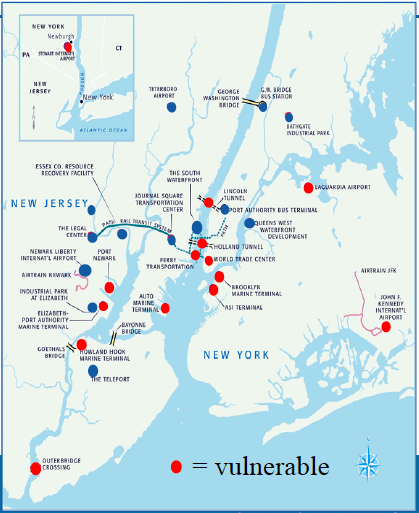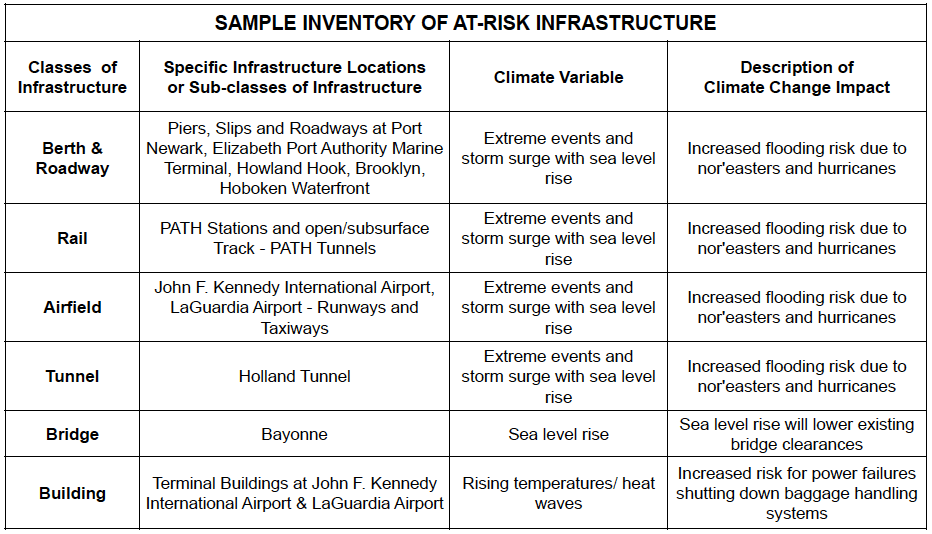Saving NYC: Can a transportation agency beat climate change?

Hurricane Sandy gave them a glimpse into the future with climate change. Now they've invested the time and money to make a plan. Can the Port Authority of New York and New Jersey get its act together to save itself?
For over 90 years, one agency has been responsible for building, operating, and maintaining the infrastructure critical to the New York/New Jersey region’s trade and transportation network: the Port Authority of NY & NJ (PANYNJ). Its facilities include America’s busiest airports, marine terminals and ports, the PATH rail transit system, six tunnels and bridges, a bus terminal, and the World Trade Center. The success of its operations affect over 17 million people who live and work in a region that accounts for almost 10% of the U.S.[i]
Compared to other major cities around the world, New York is disproportionately vulnerable to climate change with over 500 miles of coastline exposed to sea level. In 2011, a presentation at the European Geosciences Union (EGU) asserted that New York City can expect to see a 20% higher sea level rise (SLR) than the global average estimate of 28 cm (1 ft.) by 2100.[ii] This predicted an SLR of 12 to 55 inches by 2080. An examination of the PANYNJ infrastructure reveals that most of it lies near bodies of water susceptible to SLR and estimates predicted that half of these facilities could be impacted.[iii]

In October 2012, Hurricane Sandy hit New York, causing 43 deaths and nearly $19 billion in damages.[iv] The storm surges, flooding, and loss of electrical power led to further disruptions in transportation, healthcare, and other systems. In the aftermath of Sandy, millions who had come to rely on PANYNJ facilities and services found themselves stranded.[v] Hurricane Sandy was a sobering reminder that these estimates are quickly transitioning from being probabilities to becoming realities. With sea levels projected to continue to rise, this was just a preview of what the agency will face over the next century.
How is the PANYNJ adapting?
Just before Hurricane Sandy, the PANYNJ had formed the Climate Change Adaptation Task Force to determine which infrastructure assets were at risk from climate change and to develop strategies to protect these assets in the long term planning of the agency.

A risk matrix was used to prioritize assets. For example, if an asset had a high likelihood of being affected and would undermine the PANYNJ operations, it would warrant the immediate development of strategies to mitigate the risk. Since in the event of a major storm, populated areas might need to be evacuated, efforts were made to ensure that certain transportation systems continued to operate in these emergency scenarios.
To effectively mitigate these risks, the Task Force recommended a set of strategies, ranging from steps to protect against the impacts of climate change (Adaptation), steps to minimize the magnitude and duration of disruptive events (Resilience), and steps to reduce future adverse environmental impacts of the design and operations of the agency (Mitigation).[vi] Proposals for the adaptation steps, for example, included capital investment initiatives such as the installation of new flood barriers and elevation of certain infrastructures to maintenance-oriented initiatives such as using sandbags and portable pumps.[vii]
So now what?
The expansive set of strategies identified by the Task Force reflect the complexity and uncertainty in knowing how to best address the impacts of climate change. The big question is where to dedicate resources. Do they invest in flood barriers, plant a green roof, or move the building? These are not distinct approaches. While it may be tempting to first tackle resilience and mitigation strategies because the results are often associated with money savings (e.g. energy efficiency) and can be recognized within a shorter time frame, adaptation strategies lead to longer term benefits and minimize future risks.
PANYNJ will need to recognize how the strategies overlap, when they are reliant on one another, and how to mitigate risks across them all while maintaining flexibility to address unexpected disasters. The goal for the PANYNJ should be to limit climate change impacts to a level that enables the agency to adapt to it, all while trying to minimize its negative impact on climate change through its operations.
Word count: 799
Cited Sources:
[i] Brian J. McLaughlin, Scott D. Murrell, and Susanne DesRoches, “Anticipating Climate Change,” Civil Engineering (2011): 50-55, accessed November 2, 2016. https://www.panynj.gov/about/pdf/Eng-Climate-Change-Article.pdf.
[ii] Richard Black, “New York Set to Be Big Loser as Sea Levels Rise,” BBC News, April 8, 2011 (as cited in Mills-Knapp).
[iii] Christopher Zeppie and Lena DeSantis, “Adapting to Climate Change at the Port Authority: Preparing and Progressing Strategies” (presented at the 91st Annual TRB Meeting, January 24, 2012), http://cta.ornl.gov/TRBenergy/trb_documents/2012_presentations/565_Zeppie_Adapting_to_Climate_Change.pdf.
[iv] NYC.gov. “Chapter 1: Sandy and its Impacts,” http://www.nyc.gov/html/sirr/downloads/pdf/final_report/Ch_1_SandyImpacts_FINAL_singles.pdf.
[v] Jeff Goodell, “Can New York Be Saved in the Era of Global Warming?,” Rolling Stone, July 5, 2016, accessed November 2, 2016, http://www.rollingstone.com/politics/news/can-new-york-be-saved-in-the-era-of-global-warming-20160705.
[vi] Sara Mills-Knapp, Emily Bourdeau, Gregory Falco, Cathy Resler, Harold Tovar, and Stephen Zoegall, “Climate Change Adaptation and Sustainable Design at the Port Authority of New York and New Jersey” (Columbia University, May 11, 2011), http://www.earth.columbia.edu/sitefiles/file/education/capstone/Capstone_final_5_11_11_reduced.pdf.
[vii] Brian J. McLaughlin, Scott D. Murrell, and Susanne DesRoches, “Anticipating Climate Change,” Civil Engineering (2011): 50-55, accessed November 2, 2016. https://www.panynj.gov/about/pdf/Eng-Climate-Change-Article.pdf.
Other Sources:
Exhibit 1 & 2: Christopher Zeppie and Lena DeSantis, “Adapting to Climate Change at the Port Authority: Preparing and Progressing Strategies” (presented at the 91st Annual TRB Meeting, January 24, 2012), http://cta.ornl.gov/TRBenergy/trb_documents/2012_presentations/565_Zeppie_Adapting_to_Climate_Change.pdf.
Feature image: NBC New York, http://www.nbcnewyork.com/news/local/Flooded-Subways-NYC-Brooklyn-Battery-Queens-Midtown-Tunnel-MTA-Hurricane-Sandy-176359011.html.



What comes to mind here is the role of the organisational structure.
Is part of the problem that PANYJ has created a separate Climate Change Adaptation Task Force that only has the power to “recommend”? Would it work better if they integrate climate change goals into the KPIs of existing leaders who already possess the authority to act?
The scale of what needs to be done is staggering. It appears the Port Authority has approached this problem with a short term view that focuses on certain key assets. Wouldn’t a more drastic strategy be appropriate for a dense, old city that exists entirely on islands and peninsulas?
I think you highlight a very important issue. So much of the climate change risk is out of the hands of the NYC transportation agency, and therefore recognizing and optimizing resource deployment will be critical in their ability to combat these risks. I wonder, as well, how the agency can continue to use green methods to reduce transportation costs, while partnering with for-profit organizations to achieve superior results for the city.
Your post highlights the exceptional and unique role played by the PANYNJ — both in terms of the scope of their operations, and the particular vulnerability the NYC metro area has to climate change. An ongoing challenge for the agency and its ability to adapt involves having to satisfy the multiple jurisdictional stakeholders in NY and NJ — many of whom you identify in your post. How can they ensure that their prioritization efforts and investments are sound and consider collective outcomes?
A related conversation: In the aftermath of Hurricane Sandy, the Obama administration launched an initiative called “Rebuild By Design” — a design competition focused on 10 communities within the NYC metro area with an array of infrastructure challenges (http://www.rebuildbydesign.org/our-work/sandy-projects). The project was inspired and helmed by leading Dutch water engineers (http://www.nytimes.com/2014/04/13/magazine/how-to-think-like-the-dutch-in-a-post-sandy-world.html). However, the teams faced considerable implementation barriers when it came to satisfying the demands of the various municipalities, states, community groups, and others with skin in the collective NYC resiliency plan. Hoboken wanted something different than Manhattan, etc. I wonder, given our fragmented governmental landscape, how we can move to develop regional resiliency plans that offer scale benefits and allow different agencies/groups to pool resources?
Adverse weather conditions impact airline operations quickly. The impact of these trickle down to other locations in the network, as we have seen in the United case. Customers stuck at airports may be at higher risk also as they are further away from the safety of their homes. I wonder whether the risks at airports are higher granting more immediate action.
Reducing the carbon dioxide emission of the overall transportation operations, as suggested above, is another key pillar here in my opinion as it can mobilize the broader population for a good cause.
Very interesting topic. Infrastructure is a key aspect and driver of economic growth, and that is where we will see very large effects from climate change. It will be interesting to see what cities and governments can do going forward to build resilient cities and avoid large disasters like Hurricane Sandy. The GSD at Harvard is exploring some of these topics, so I would suggest checking out the GSD work sometime.